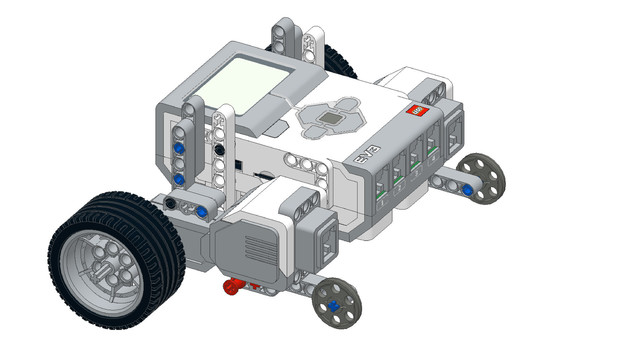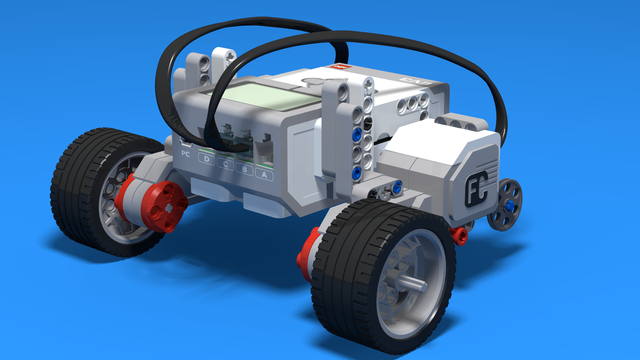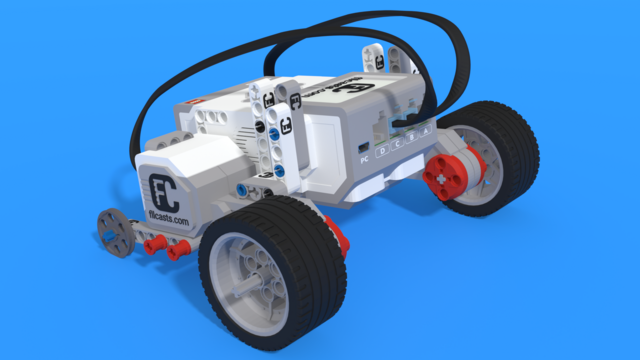When we, the teachers, make programs and projects, we give them descriptive names. Let's show you a way to put cool names on your programs.
- #368
- 04 Feb 2017
- 2:26
You start with a single program for every project. You can create new programs with the small Plus ("+") sign.
If a project has any unsaved changes, there will be a small asterisk (*) in the project name.
We communicate via programs and projects
If you need help with your robot, you can send us your program.
When we teach you, we share exemplary programs with you.
Always give names to your programs. This way you demonstrate that you care for what is happening with the robot.
The name should describe the task, usually with a verb and a noun. You can change the name of a program with a double click.
Good names for a program could be:
"grab ball",
"move forward", etc.
Never put abbreviations in the names. They mean something to you right now, but mean nothing to a stranger. They could mean nothing to you as well, say, a week later, when you've forgotten what you meant.
Demonstration at the end of the class
Create a new program for each task and save it with a descriptive name.
Every new task should be created in a new program and these programs must have descriptive names. Don't simply overwrite one program all the time.
When you have many programs in the project, you can make a demonstration of what you have done at the end of the class or record a video for us that you can share in the comments underneath this section.
English
In the course I'd like to share our programs with you and you can find most of the programs below in the material sections.
Because we need to communicate with this programs we must also have proper names for this programs. I can't just name each of our programs just 'program' or each of our projects just 'project'. So I must give names to our programs. First, you can see that our project is not saved. So I'll just click 'File', 'Save Project As' and right here I'll select a name for my project. And the name of my project is let's call it the name of the module intro_ev3. So that's the name of the project. And in this project the first task that we've solved is actually moving forward. Now just double click on the program and here I can type. And it's always a good idea to have a noun or a verb because the program is actually something that the robot does. So, it's a move and it's move_forward.
And again I'll just save. Now you can find the program below in the material section and you'll have a project called intro_ev3 and in this project you'll have a new program called move_forward. It's always a good idea to name your programs because in this way you can keep track of the changes that you make. You can have a whole project with all the programs from the current class. You can show this programs, you can share them. And to do all of these good things you must have good names for your programs. And even if you return to your program a few days back or a few weeks if it has a good name, you can just remember from the name what the program does. So, always try to give good names to your programs.
Courses and lessons with this Tutorial
This Tutorial is used in the following courses and lessons

EV3 Phi. Introduction to robotics with LEGO Mindstorms
The things that you will be able to do with your EV3 robot by the end of this course are:
Freely move your robot towards desired target;
Avoid obstacles on the path of your robot using sensors;
Follow lines of any shape;
Detecting and picking up objects of any kind;
- 92
- 220:20
- 36

First challenge - Yo Yo task
Overview of what is going to happen that part of the lessons.
- 14
- 0
- 4
- 3d_rotation 0

Instructors Remote Training
If you are working with students and you want to introduce Robotics to your class or you want to mentor a FLL team, but you are insecure about your technical knowledge in the Robotics field, then this is the right place for you. Having in mind teachers' busy schedule, we have design two different schedules and added an option to design one just for you. FLLCasts's Mindstorms EV3 Robotics Online Training is the perfect match for any teacher.
After the completion of each task the participant has to upload his solution for verification.
- 183
- 280:11
- 156

How to make the robot move
Let's review the LEGO Mindstorms EV3 Intelligent Brick
The EV3 brick is the main computer of your LEGO robot and it has a display, a few buttons and various ports.
- 24
- 0
- 11
- 3d_rotation 0

Robotics with LEGO - Level 1.0 - Adventure in Space
The first level of the Robotics with LEGO curriculum for students in fifth to twelfth grades.
Various constructions with robots are built. Learn how to control the motors so that the robot navigates around the Moon and Earth in various ways. Getting to know the first two sensors. The robot can feel its surroundings with the help of the Touch sensor and avoid obstacles.
The Ultrasonic distance sensor can help the robot avoid obstacles. Students work with concepts like loop, degrees and medium motor. Robots can now do two different actions at the same time - while solving missions on a field, the third motor clears detected obstacles.
- 126
- 123:52
- 150

Създайте и качете първата си програма
Children tend to imitate. The easiest way to do something is to first see how it’s done. So, sit down and show your students how to program.
- 8
- 0
- 1
- 3d_rotation 0

Level A1. Introduction. Robotics with LEGO
Introduction to robotics - The first level of the Robotics with LEGO curriculum for students in second, third or fourth grades. A journey in space, with robots. Various constructions with robots are built. Learn how to control the motors so that the robot navigates around the Sun, the Moon and Earth in various ways. Getting to know the first of the sensors. The robot can feel its surroundings with the help of the Touch sensor and avoid obstacles.
- 142
- 133:42
- 187

Create and upload your first program
Children tend to imitate. The easiest way to do something is to first see how it’s done. So, sit down and show your students how to program.
- 8
- 0
- 1
- 3d_rotation 0

Level A1. Introduction. Robotics with LEGO
Introduction to robotics - The first level of the Robotics with LEGO curriculum for students in second, third or fourth grades. A journey in space, with robots. Various constructions with robots are built. Learn how to control the motors so that the robot navigates around the Sun, the Moon and Earth in various ways. Getting to know the first of the sensors. The robot can feel its surroundings with the help of the Touch sensor and avoid obstacles.
- 142
- 133:42
- 187

Lesson 2 - Yo-yo challenge
Introduction
Today we will learn to program the robot to perform more than just one action, as well as program it to move like a yo-yo. Have you ever played with a yo-yo? How does it move? Did you know that from Filipino yo-yo means "to return".

- 18
- 3
- 8
- 3d_rotation 1
![Image for [In Development] The fun level - Game-oriented introduction to LEGO robotics](https://d2nmr6p48f8xwg.cloudfront.net/content_pictures/pictures/000/002/636/a4f229bae5979562f6bfe32adc6281e577e312674a0cc5c98f8fdfe15e7c7da9b89f826a037575a5LEGO-Mindstorms-Ev3-Yolanda-Sailship-Robot-Fllcasts.png)
[In Development] The fun level - Game-oriented introduction to LEGO robotics
A level, designed for introduction in LEGO-robotics, focused mostly on games. We use goal-oriented challenges to make the students want to accomplish a certain task, learning a lot in the process. Some of the games we have included here are football, bowling, paper-plane competition and many more. It is suitable for studens 8 to 12 years old, but even older students will have a lot of fun with the activities.
This is a brand new course that we are experimenting with in a groups in June 2019. Keep in mind that it is possible to use it for summer camps and groups, but there are a few lessons that will be improved on the fly.
- 38
- 42:14
- 40

Lesson 1 - Introduction
Introduction
Today the robot we are building is a spaceship once again. The aim for today, however, is exact - to reach the further (dark) side of the moon!
Where is located the dark side? Why is it so hard to be reached? Why is it called "dark"?
- 23
- 3
- 15
- 3d_rotation 1